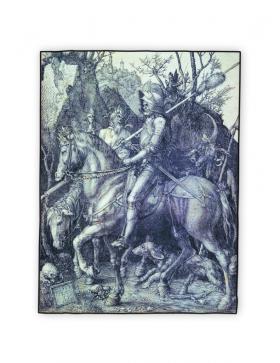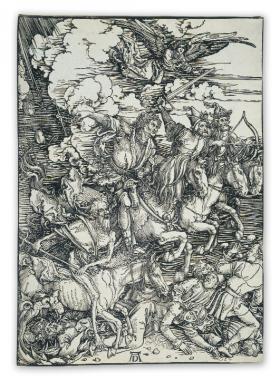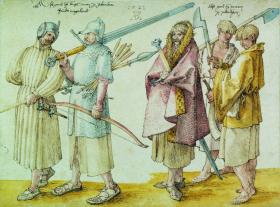Albrecht Dürer: first superstar of northern European art
Published in Early Modern History (1500–1700), Issue 1 (Jan/Feb 2006), News, Volume 14
Knight, Death and the Devil (1513). (Chester Beatty Library)
Albrecht Dürer (1471–1528) was the first superstar of northern European art. Vasari’s Lives of the artists (1568) describes Dürer as a ‘truly great painter and creator of the most beautiful copper engravings’. In typically chauvinist manner, the Florentine artist-historian further states that if Dürer had been born a Tuscan and had learned Italian technique fully, his ability, diligence and versatility would have made him the greatest painter of all. In Dürer’s self-portraits we can see not only someone who was a natural draughtsman but also a man of considerable self-belief. At the age of thirteen he made a remarkable silverpoint drawing of himself, and then, having been to Italy, where painters had a more elevated social status, he painted himself at 26 as a Venetian gentleman and then at 28 as Christ.
Dürer had natural genius and imbibed Italian Renaissance influences, but it was northern technology—the printing press—that made him. This recently invented piece of information technology allowed for the first time the easy and rapid replication not only of texts but of images as well. Like Gutenberg, Dürer was from a family of goldsmiths. With his talent as an artist already evident, he was apprenticed into the printing trade in his native Nuremburg, working on woodcuts and then engravings. These techniques weren’t easy, as they involved cutting out from wood or incising on copper plate reverse images of what was ultimately printed. Gradually he moved from illustrating the books of others to issuing for sale single engravings on religious, humorous or populist subjects, with his famous intertwined ‘AD’ as trademark.
This market orientation was profitable and made him less dependent on the rich patrons sought after by other artists. The sale of his exquisite work in multiple form spread certain images created or copied by him all over Europe. For instance, his woodcuts of the Resurrection published north of the Alps in 1510 were utilised by the Italian painter Jacopo Pontormo to execute a fresco for the monastery of San Lorenzo al Monte outside Florence between 1523 and 1525. In effect he was contributing to the development of a new mass international visual culture. This ‘globalisation’ also led to the use of print for publicity and propaganda. Here it was Dürer who was sought after. The great humanist scholar Desiderius Erasmus, realising the power of this image-making, went to great trouble to have a portrait engraved by the German master. This is not to say that Dürer was simply an entrepreneur. He certainly did not spurn offers when they came from the top, and in the 1510s he followed the Emperor Maximilian on progress, working on commissions.
The Chester Beatty exhibition shows Dürer’s progression from apprentice to master print-maker, from early work illustrating the Nurnberg Chronicles (1493) and the Ship of Fools (1497) through to single masterpieces such as ‘Knight, Death and the Devil’ (1513) and ‘Melencolia 1’ (1514). He was plainly always good at folds in clothes—they are almost tangible. But his Italian trips saw his image production being positively enhanced over the years by better use of perspective and more light and shade. Nevertheless, in spite of these classicising tendencies, his female nudes remain delightfully natural and chunky. Indeed, it is the northern-inspired stuff that provides my favourites. There are his woodcuts of a monstrous pig and of a horse’s backside. There is the fabulous engraving of ‘The Prodigal Son Amid the Swine’ that was much admired by Vasari. It looks like something from the repertoire of his contemporary Hieronymous Bosch. Then there is his marvellous representation of a peasant couple dancing—surely a very saleable and popular item with the public.

The Four Horsemen of the Apocalypse—Dürer put them into the same image for the first time. (Chester Beatty Library)
Dürer was also innovative in how he represented his subject matter—putting the Four Horsemen of the Apocalypse into the same image for the first time and giving the Holy Family an ox as well as a donkey in their Flight into Egypt. He made a print of St Eustace (a Roman general, originally called Placidus, converted whilst out hunting) saleable by putting five dogs in different poses into the foreground. The sheer quality of Dürer’s print work and his mastery of light and shade is well brought out in the exhibition, where his ‘Passion’ series of 1508 is displayed side by side with a set that Hans Mack, another Nuremburg artist, decided to colour in—and effectively devalued—in 1585.
Visitors to the exhibition are also treated to some of Dürer’s drawings. The Kunsthalle in Bremen has lent two such items: ‘The Proportional Figure of a Standing Man’ (1513), one of Dürer’s studies in human proportion, and ‘Sick Dürer’, a self-portrait of the artist pointing plaintively at the side of his stomach. But Irish history buffs will most likely make a beeline for the watercolour of ‘Irish Soldiers and Peasants’ lent by the Kuperferstichkabinett Staatliche Museen, Berlin, on show in Ireland for the first time. This image is dated 1521 and is therefore thought to have been executed in Antwerp, which Dürer visited that year. It is the earliest representation of Irish dress and as such is frequently used in books as a depiction of Irish soldiers.
However, there is now a question mark over the latter claim. Jean Michel Massing raised the matter in the Irish Arts Review in 1994. Antwerp was a great entrepôt trading city and it would certainly have been the place, if anywhere, to have encountered such outlandish people as the Irish and others whom Dürer placed in his album of peoples in costume. The problem is that the blokes with moustaches have only two authentic Irish items—a ring-hilted great sword favoured by Irish gallowglasses held by the second from the left, and the Irish mantle worn by the third from the left. Such swords were actually made in Germany for export, whilst Irish mantles—a sort of poor man’s fur coat, known for its warmth—were imported onto the Continent. So it is quite possible that these items were available in Antwerp—indeed, the city was known for its processions of citizens dressed up as foreigners at festival time!
The clincher would seem to be the legend on the watercolour. It does not actually say that these are Irish soldiers and peasants. It states more enigmatically: ‘Thus go the soldiers of Ireland beyond England/Thus go the poor of Ireland’. Furthermore, as Massing also reminded us, it was Dürer who used a blond German youth dressed in feathers to represent an Amerindian in a Book of Hours for the emperor!
Finally, it ought to be noted that this image of Irish soldiers was not put into print circulation by Dürer contemporaneously and hence it never affected the developing Renaissance image of the Irish. It only came into general circulation when scholarly interest in Dürer developed in the late nineteenth century and his albums of drawings were finally published.
Hiram Morgan lectures in history at University College Cork.

‘Thus go the soldiers of Ireland beyond England / Thus go the poor of Ireland’—Dürer’s watercolour of ‘Irish soldiers and peasants’ (1521). (Kuperferstichkabinett Staatliche Museen, zu Berlin)
















